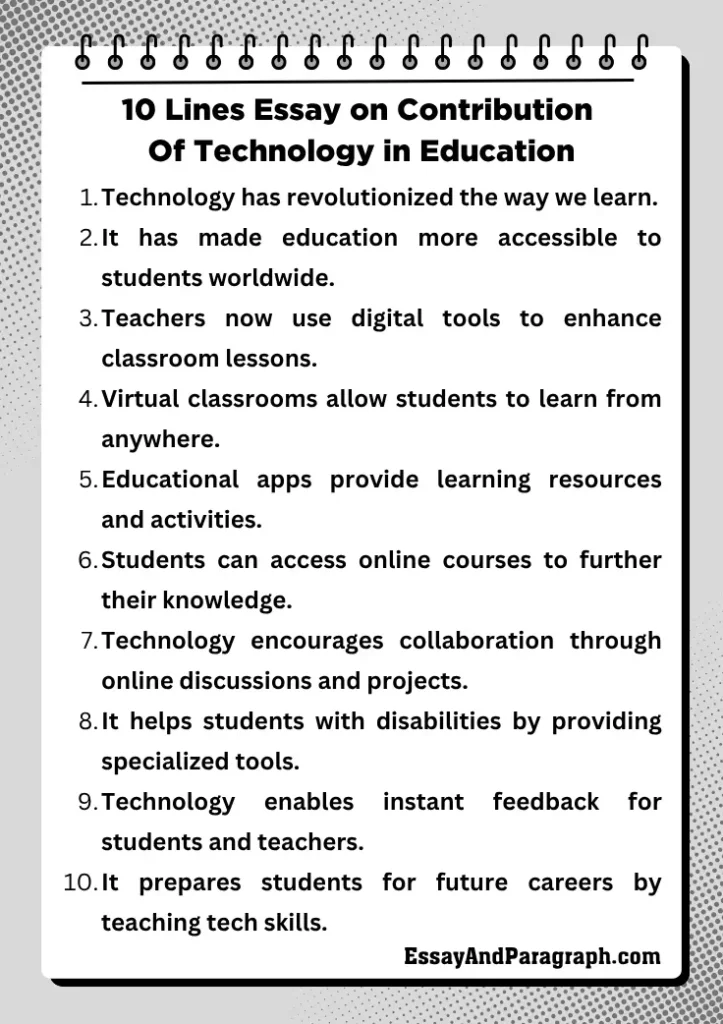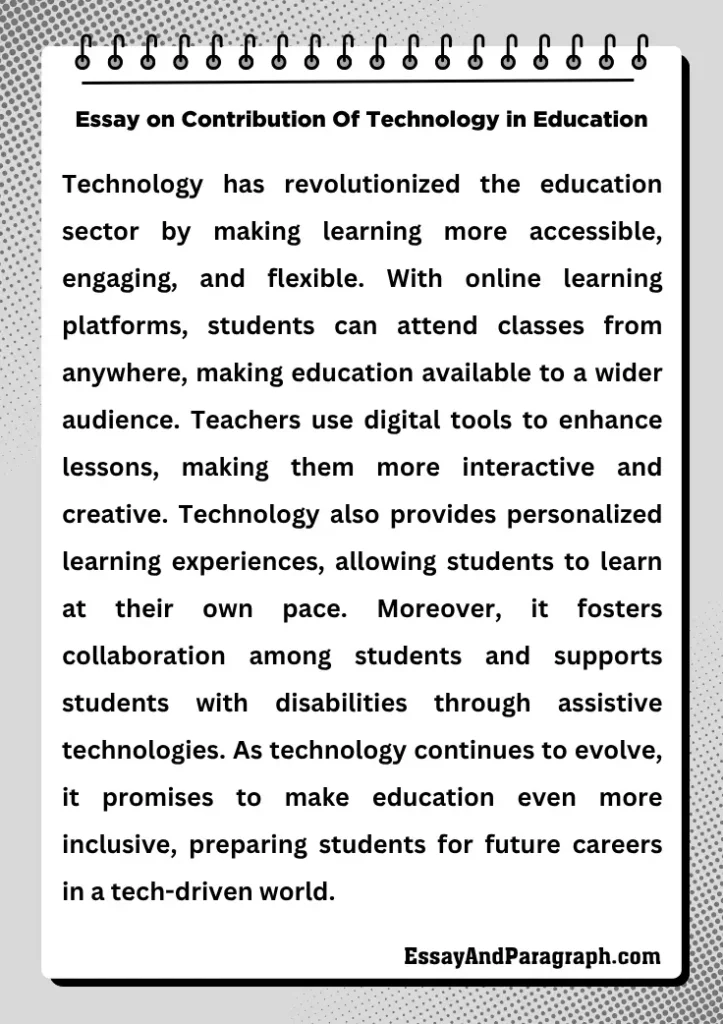Have you ever wondered how technology is changing the way we learn? Technology has made a significant impact on education, making learning more interactive, engaging, and accessible. It brings new opportunities for students and teachers to communicate, learn, and grow. In this article, we will learn how technology is contributing to education, from virtual classrooms to educational apps and beyond.
10 Lines Essay on Contribution Of Technology in Education
Technology has revolutionized the way we learn.
It has made education more accessible to students worldwide.
Teachers now use digital tools to enhance classroom lessons.
Virtual classrooms allow students to learn from anywhere.
Educational apps provide learning resources and activities.
Students can access online courses to further their knowledge.
Technology encourages collaboration through online discussions and projects.
It helps students with disabilities by providing specialized tools.
Technology enables instant feedback for students and teachers.
It prepares students for future careers by teaching tech skills.

Essay on Contribution Of Technology in Education – 100 words
Technology has greatly impacted education by making learning easier, more engaging, and accessible. With the help of digital tools like online classes, educational apps, and virtual learning environments, students can access education from anywhere. Teachers now have resources to create interactive lessons, encouraging creativity and critical thinking. Additionally, technology enables students to collaborate, learn at their own pace, and receive instant feedback. This transformation in education is not only preparing students for future careers but also making learning more personalized and enjoyable for everyone involved.
Essay on Contribution Of Technology in Education – 200 words
Technology plays an essential role in modern education, changing how students and teachers interact. With online education platforms, students can now access learning resources at their convenience. Virtual classrooms have made education possible for people who cannot attend in-person lessons due to geographical or personal constraints. Students can join live lessons or watch recorded sessions, ensuring that they never miss out on their studies.
Furthermore, technology enhances classroom learning by offering a variety of tools such as smartboards, tablets, and educational apps. These tools make lessons interactive, fun, and engaging. Students can easily access additional learning material, complete assignments, and take quizzes on their own time.
Technology also promotes collaboration among students through online discussions, group projects, and peer-to-peer interactions. Instant feedback from teachers and adaptive learning technologies allow students to progress at their own pace. Technology is especially beneficial for students with special needs, providing them with tools tailored to their learning requirements.
As we move into the future, the role of technology in education is expected to grow even more, empowering both students and teachers to explore new methods of learning and teaching. It’s a win-win for everyone involved.
Essay on Contribution Of Technology in Education – 250 words
Technology has transformed education by offering more flexibility, accessibility, and creativity. In the past, students could only learn in physical classrooms, but with the development of technology, education is now at the fingertips of anyone with an internet connection. Virtual learning platforms and online courses have made it easier for students across the world to attend classes, whether they’re in a remote area or in a busy city.
Teachers have also embraced technology, using smartboards, tablets, and interactive software to enhance lessons. These tools help explain difficult concepts in ways that are both engaging and memorable. For example, a student studying math can use an app to visualize problems, making them easier to understand.
One of the most significant contributions of technology to education is its ability to make learning more inclusive. Students with disabilities now have access to assistive technologies, like speech-to-text software, that support their learning needs. This technology ensures that every student, regardless of their challenges, has an equal opportunity to succeed.
Technology also provides real-time feedback, allowing students to track their progress and make improvements. Teachers can assess students instantly, enabling them to adjust lessons and provide more personalized attention. The future of education looks even brighter as more innovative technologies are developed, further enhancing learning experiences and opportunities.
Essay on Contribution Of Technology in Education – 500 words
The role of technology in education has evolved significantly over the years. In the past, students and teachers relied on traditional methods, such as textbooks and chalkboards, to impart and receive knowledge. Today, however, technology has completely transformed the landscape of education, making it more engaging, interactive, and inclusive.
One of the most noticeable ways technology contributes to education is through online learning platforms. These platforms offer students the ability to access courses, lectures, and study materials from anywhere in the world. This level of accessibility has opened doors for students who might otherwise have had difficulty accessing education due to location, time, or financial constraints. Students can attend virtual classes, watch recorded lectures, and interact with their peers in real-time, offering a more flexible learning experience.
Moreover, technology has provided teachers with innovative tools to enhance the learning experience. From interactive whiteboards to learning management systems, teachers can now deliver lessons in creative ways that capture students’ attention. Educational apps and online resources provide students with additional materials, exercises, and assessments to reinforce learning outside the classroom. This makes learning a continuous process, not confined to the traditional classroom setting.
Another important contribution of technology to education is the ability to make learning more personalized. Adaptive learning technologies allow students to learn at their own pace, providing customized lessons and activities that suit their unique needs. Students can review material as many times as necessary until they fully understand the topic, ensuring a stronger grasp of the subject matter.
Technology also promotes collaboration among students. Online discussion forums, group chats, and shared documents allow students to work together on projects, even when they are not physically in the same location. This fosters teamwork, communication skills, and the exchange of ideas. It also allows students to learn from their peers, creating a rich and diverse learning environment.
For students with special needs, technology has been a game-changer. Tools like speech recognition software, text-to-speech applications, and screen readers have made learning more accessible for students with disabilities. These technologies provide alternative ways for students to engage with content and complete assignments, helping them overcome challenges they may face in a traditional learning environment.
The impact of technology on education extends beyond the classroom. Students are learning valuable skills that will help them succeed in their future careers. In today’s world, proficiency in technology is essential, and students who are exposed to digital tools and online learning platforms are better prepared for the workforce. Technology teaches students not only academic subjects but also essential skills such as problem-solving, critical thinking, and digital literacy.
As we look to the future, the contribution of technology in education is expected to grow even more. The integration of virtual reality, artificial intelligence, and other cutting-edge technologies will continue to transform the way students learn and interact with their education. These advancements will help create a more personalized, efficient, and accessible educational experience for students around the world.
FAQs
1. How does technology benefit students in education?
Technology provides students with access to learning resources beyond the classroom. It offers online courses, virtual classrooms, and educational apps that make learning more flexible and accessible. Technology also allows students to learn at their own pace, collaborate with peers, and receive instant feedback, which enhances their educational experience.
2. Can technology help students with disabilities?
Yes, technology plays a vital role in supporting students with disabilities. Assistive technologies such as speech-to-text software, screen readers, and audio learning tools enable students to access and engage with educational content in ways that meet their specific needs. This ensures that all students, regardless of their challenges, can succeed in their studies.
3. How does technology enhance teacher-student interaction?
Technology provides teachers with tools to create more engaging and interactive lessons. Digital tools like smartboards, educational apps, and online platforms allow for real-time communication, enabling teachers to give immediate feedback and adjust lessons to better meet student needs. It also encourages more student-teacher interaction outside the classroom.
4. What role does technology play in collaboration among students?
Technology allows students to collaborate with each other through online discussion boards, shared documents, and group chats. These tools foster teamwork, enhance communication, and encourage the exchange of ideas, making it easier for students to work together on projects and assignments, even when they are not physically in the same location.
5. How is technology changing the future of education?
The future of education will continue to be shaped by emerging technologies such as artificial intelligence, virtual reality, and online learning platforms. These technologies will further personalize learning, making education more accessible, engaging, and inclusive for students worldwide. They will also prepare students with the skills they need for future careers.
6. Is technology in education beneficial for students of all ages?
Yes, technology benefits students of all ages. For young children, interactive educational games and apps make learning fun and engaging. For older students, technology offers resources such as online courses, digital textbooks, and collaborative tools that make learning more efficient and flexible. It’s adaptable for students at any stage of their education.
Top 5 quotes on Contribution Of Technology in Education
“Technology will not replace teachers, but teachers who use technology will replace those who don’t.” – Unknown
“Education is the most powerful weapon which you can use to change the world.” – Nelson Mandela
“The future of learning is not about technology, but how we use it to create meaningful experiences.” – Unknown
“Technology is best when it brings people together.” – Matt Mullenweg
“The purpose of education is to replace an empty mind with an open one.” – Malcolm Forbes
Summary
Technology has revolutionized the education sector by making learning more accessible, engaging, and flexible. With online learning platforms, students can attend classes from anywhere, making education available to a wider audience. Teachers use digital tools to enhance lessons, making them more interactive and creative. Technology also provides personalized learning experiences, allowing students to learn at their own pace. Moreover, it fosters collaboration among students and supports students with disabilities through assistive technologies. As technology continues to evolve, it promises to make education even more inclusive, preparing students for future careers in a tech-driven world.


